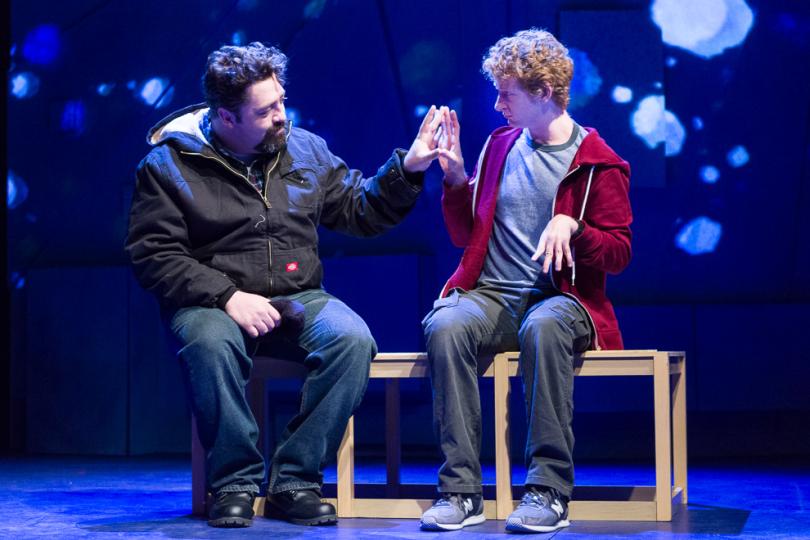The Curious Examination of “Normal” Communication

The Curious Case of the Dog in the Night-time, opened this weekend at Mixed Blood Theatre. The latest play from the “autism cannon “ (as Director and Producer, Jack Reuler, has dubbed it), it is a curious play that beautifully explores the world from a different, perhaps more practical, point of view. It shows how often we get caught up in our own personal problems and burdens of reality and how those self proclaimed problems cloud our judgment and limit the ability to see what’s really in front of our noses. How should I interpret that remark? How should he read this text? What does that look from her really mean?
Reuler points out that this play “doesn’t (ever) use the word autism,” and though we understand that the main character, Christopher, is “different,” (takes everything literally, has trouble with social cues, and trusts his parents to be good people), the play is more an examination of how, so called, “normal” people use manipulation, promises, to get out of being responsible for their own actions. In introducing the idea that “metaphors are (consequently) lies,” and that something being “like” something else cannot be, because it is “not’ actually that thing, this play really forces us “normal” folks to hold up a proverbial mirror and face some ugly truths about how we communicate with others.
The stage is set in a thrust, awash in blue light. The preshow is a projection of a multicolored eye that folds into it’s own pupil over and over again and represents a take on perception and point of view. Cool. When the show opens we are introduced to the strong ensemble cast, as well as CHRISTOPHER (an excellent MacGregor Arney) with his journal, being read by his beloved teacher SIOBHAN (Regan Linton). The scenes are cinematic and the characters morph between an ANGRY NEIGHBOR, CREEPY UNCLE to WINDOW BOX outside of the kitchen or the TOILET PAPER STAND in the bathroom. The actors sit in reserved front row seats so they can easily and quickly pop up as an ATM MACHINE, or for a one liner as the HIGH SCHOOL PRINCIPAL.
The small space is transformed by certain representative props and costumes, and wooden platforms, that can be hidden in clever drawers on the side of/or fit into openings in the stage, a thoughtful and creative construction of set and set pieces by Designer, Joseph Stanley. Lighting, (Video Design-Kathy Maxwell, Lighting Design-Karin Olson) and sound elements, (Sound Design-Andrew Mayer, Composer-Eric Mayson) are very important in helping identify the environment as scenes change, whether it be on a crowded train in London, or in the neighbor's yard at night. The transitions also benefit from the textured backdrop, often imitating stars or cell like blobs. To me it was suggestive of the unknowns of space versus the unknown in the human brain (both equally daunting and exciting). The sound creates realistic locale but can be heightened into the sensory overload that often accumulates in Christopher’s mind when he’s figuratively and literally out of his comfort zone. This usually ends with him in a ball on the floor moaning and rocking until someone can recalibrate him enough to calm him down.
Arney is astounding in the lead role. His accent, speech patterns, mannerisms, are beyond impressive, even down to a complicated hand tick, and how he methodically and bizarrely opens an envelope the exact same way every time. Let’s just say I had to look up a video of him on his website to see for myself what he acts like off stage. His relationship with his father ED (Zack Myers) and his teacher Siobhan are the strongest in the play. There is chemistry, genuine love and connection between these folks on stage and it is lovely to watch. Note an interesting choice in the casting, as Siobhan, is in a wheelchair. After some research I discovered that Ms. Linton does use a wheelchair in real life. I wondered in the moment if “it was real” for a hot second, as is my conditioned behavior, but after that, so what if it’s not specified in the script? She was awesome, empathetic, kind and their friendship is a highlight of the show! So, you have a non-autistic actor playing and autistic character, and an actor with a disability playing a character with no character casting specifics. A lovely example of choosing the best actor for the role, regardless of color, sex, orientation, or disability. I think we need another term for “blind” casting no? Just a thought.
The first act is the clearest and cleanest by far but Act II seems to drag. There are SO many quick scenes, and though Movement Director, Brian Bose, does an excellent job in generally navigating people through the space, the second half would have benefitted from cutting some of that transition time. I question if this might just be an adaptation issue from novel to play because, without spoiling anything, we discover some very important information at the end of Act I, yet after the act break I wasn’t so sure what else needed to be accomplished in beginning Act II.
As we delve deeper into Christopher’s family history, his need to overcome some major anxieties, while trying to connect with his mother and father, becomes priority. This got a little muddy and repetitive, so much so, that the ending appeared almost anticlimactic. The familial issues begin to border on melodrama and Miriam Laube, Christopher’s mother JUDY, is a little too big for the space. In the front row I felt like she was projecting her emotions to those folks in the back of a much larger audience. Not to mention her character is not particularly likable. Although there are a few redeemable qualities this becomes a tough challenge for the actor to find her character's humanity. Lastly, a very under developed idea of Christopher’s journal being turning into a play is confusing, the irony being that this novel was indeed turned into the stage play being performed. However, it is weakly mentioned three times, and at one point tries to break the established reality by acknowledging the actors as...just the actors? I think it would have been cleaner to cut out that concept. This would mean finding another way to engineer the quirkiness of the postlude...but still, it was weird and took me out of the action of the play.
All pickiness aside, this play is very well done. From text to tech, from production value to players, it’s exciting, unique, and demands self-reflection. Mixed Blood takes professional theatre to another level and this piece is a perfect example. The theme for their 2017-2018 Season is Connecting the Disconnected, and in the midst of our current cultural climate, I applaud the company for challenging their audience to think outside the box, to be uncomfortable, and to laugh at things that are honest, above and beyond the cloak of political correctness. All reasons art is necessary, this show puts these components on stage front and center. Do yourself a favor and see this show before it closes. You’ll laugh, you might cry, but you’ll leave with some new ideas about people, communication and their interpretation.




